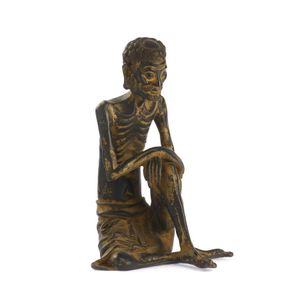Chinese Ivory Figure of Hua Mulan
You must be a subscriber, and be logged in to view price and dealer details.
Subscribe Now to view actual auction price for this item
When you subscribe, you have the option of setting the currency in which to display prices to $Au, $US, $NZ or Stg.
- Ivory - Ivory is a hard white material that comes from the tusks of elephants, mammoth, walrus and boar, or from the teeth of hippopotamus and whales. The ivory from the African elephant is the most prized source of ivory. Although the mammoth is extinct, tusks are still being unearthed in Russia and offered for sale.
Ivory has been used since the earliest times as a material for sculpture of small items, both in Europe and the east, principally China and Japan.
In Asia ivory has been carved for netsuke, seals, okimono, card cases, fan supports, animals and other figures and even as carved tusks.
In the last 200 years in Europe ivory has been used to carve figures, for elaborate tankards, snuff boxes, cane handles, embroidery and sewing accessories, in jewellery and as inlay on furniture. Its more practical uses include being used for billiard balls, buttons, and a veneers on the top of piano keys.
The use and trade of elephant ivory have become controversial because they have contributed to Due to the decline in elephant populations because of the trade in ivory, the Asian elephant was placed on Appendix One of the Convention on International Trade in Endangered Species (CITES), in 1975, and in January 1990, the African elephant was similarly listed. Under Appendix One, international trade in Asian or African elephant ivory between member countries is forbidden. Unlike trade in elephant tusks, trade in mammoth tusks is legal.
Since the invention of plastics, there have been many attempts to create an artificial ivory
Visually similar items

Chinese carved ivory figure of a woman on carved wooden stand, late 19th century. Ivory height 30.5 cm

Fine example of a cult hook. Yiman people Karawari or Blackwater river region East Sepik Province, New Guinea. Early 20th century. Wood with natural ochres. Provenance: Private Collection Chicago, USA, height 89 cm

Don Bradman, bronze statuette 'Don Bradman, Lord's 1930' by sculptor Tanya Bartlett, limited edition 177/2500, 37 cm tall, signed by the artist and dated 1999. A smaller version of her statue 'the Final farewell' at the Bradman museum in Bowral. G/VG condi

A Chinese bronze arhat, the slender arhat seated with his eyes closed as if meditating in half-leg position, his robe flowing from his waist down to reveal a torso with visible ribs, two hands resting on the left knee, 8 cm high
